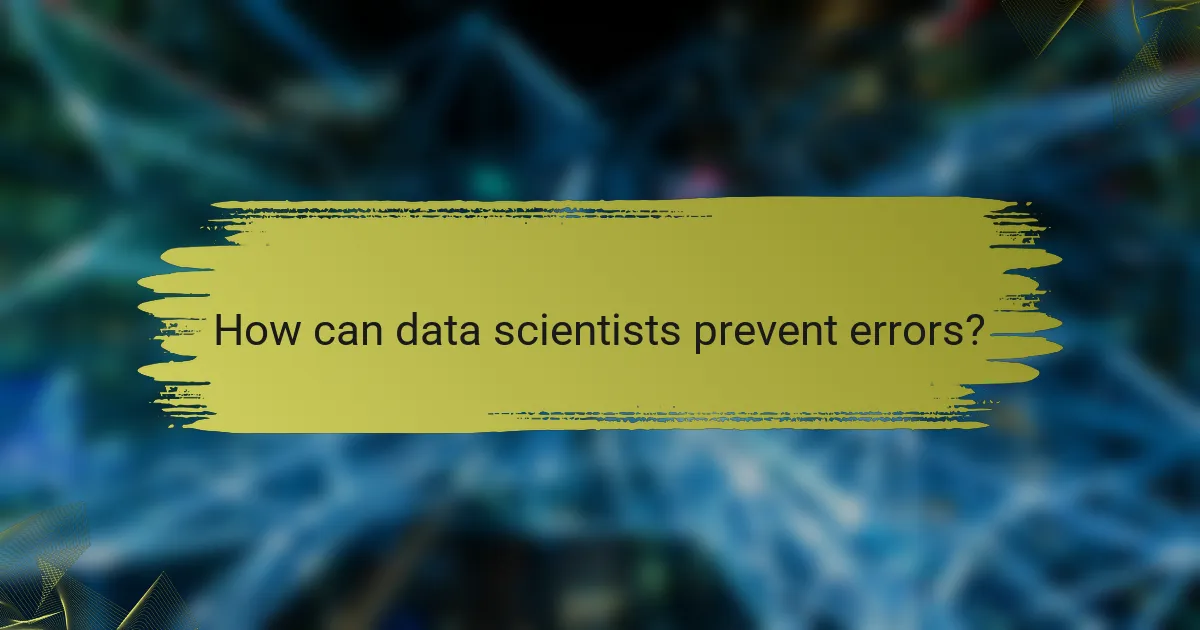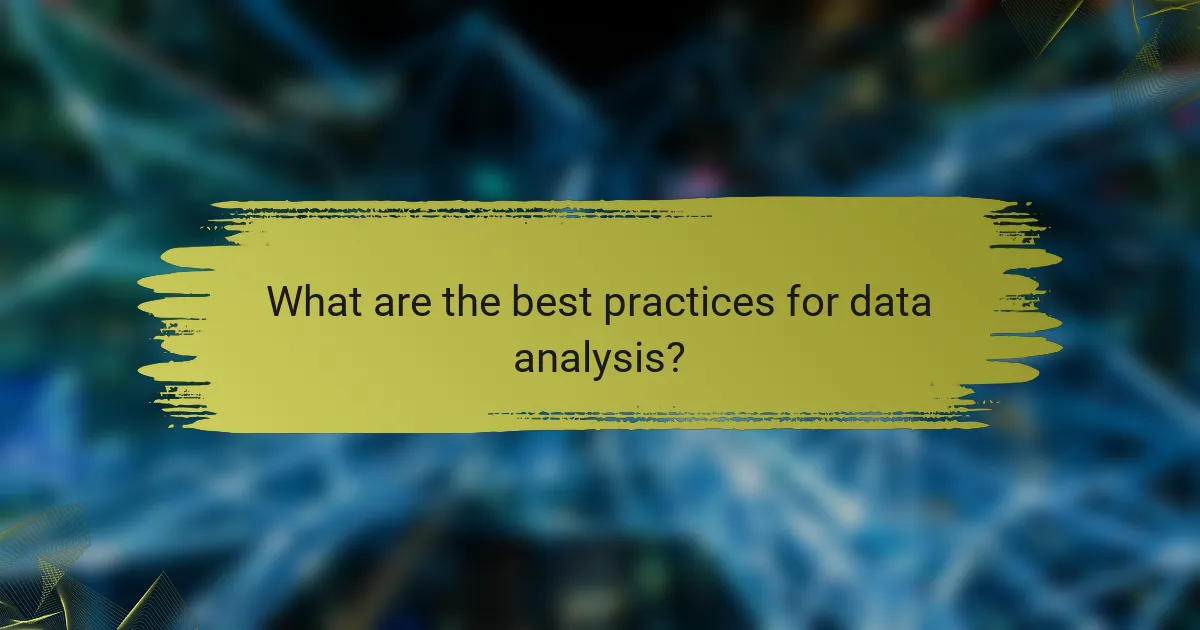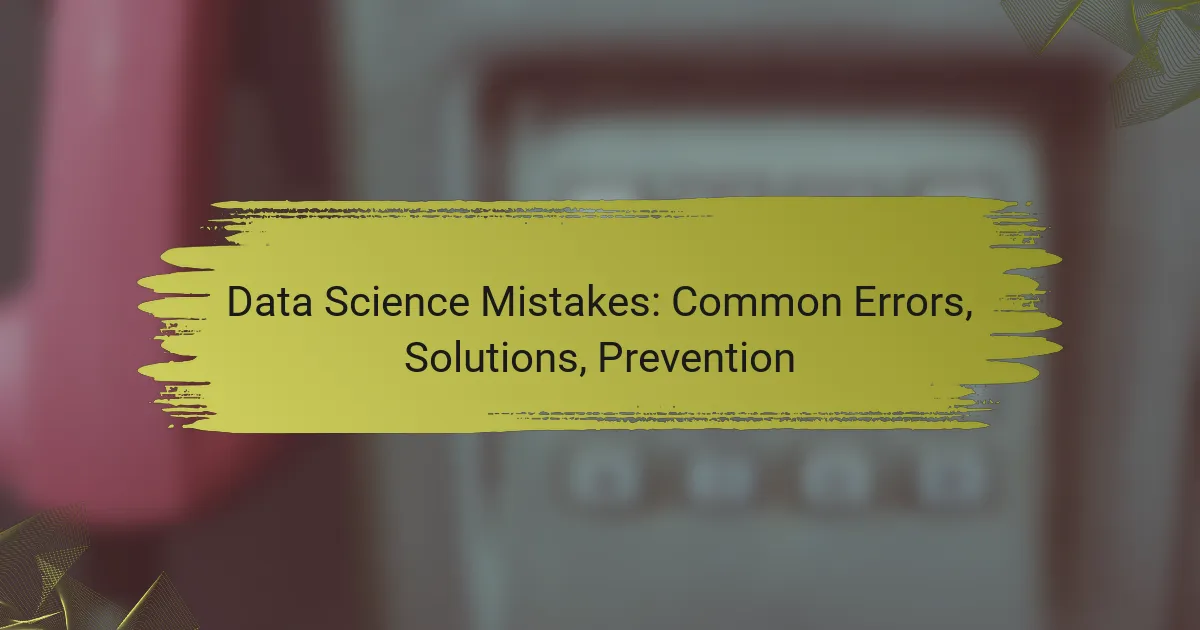In the field of data science, common mistakes such as overlooking data quality and misinterpreting results can significantly hinder the effectiveness of analysis. By understanding these pitfalls and implementing systematic approaches, data scientists can enhance the reliability of their models and the insights derived from them. Adopting best practices like data validation and thorough documentation is essential for achieving accurate and actionable outcomes.

What are the common data science mistakes?
Common data science mistakes include overlooking data quality, overfitting models, neglecting feature selection, misinterpreting results, and failing to document processes. Addressing these issues is crucial for producing reliable and actionable insights from data analysis.
Ignoring data quality
Data quality is fundamental to any data science project. Poor quality data can lead to inaccurate models and misleading conclusions. It’s essential to assess data for completeness, consistency, and accuracy before analysis.
To ensure high data quality, implement validation checks, remove duplicates, and handle missing values appropriately. Regularly auditing data sources can help maintain standards and improve outcomes.
Overfitting models
Overfitting occurs when a model learns noise in the training data rather than the underlying pattern, resulting in poor performance on new data. This is often a result of using overly complex models or insufficient training data.
To prevent overfitting, use techniques such as cross-validation, regularization, and simplifying the model. Aim for a balance between model complexity and generalization to unseen data.
Neglecting feature selection
Feature selection is critical for improving model performance and interpretability. Ignoring this step can lead to models that are too complex and less efficient. Selecting relevant features helps reduce noise and enhances the model’s predictive power.
Utilize techniques like recursive feature elimination or regularization methods to identify and retain the most impactful features. This can significantly improve model accuracy and reduce training time.
Misinterpreting results
Misinterpretation of results can lead to incorrect conclusions and decisions. This often stems from a lack of understanding of statistical significance or the context of the data. Always consider the broader implications of your findings.
To avoid misinterpretation, clearly communicate results using visualizations and ensure statistical methods are appropriately applied. Engage with domain experts to validate findings and contextualize data insights.
Failing to document processes
Documentation is vital in data science for ensuring reproducibility and transparency. Failing to document processes can lead to confusion and hinder collaboration among team members. Proper documentation helps track decisions and methodologies used throughout the project.
Establish a standard for documenting code, data sources, and analytical methods. Use tools like Jupyter notebooks or version control systems to maintain clear records of your work, making it easier for others to follow and replicate your analyses.

How can data scientists prevent errors?
Data scientists can prevent errors by implementing systematic approaches that enhance data quality and model reliability. Key strategies include employing data validation techniques, utilizing cross-validation methods, and establishing clear documentation practices.
Implementing data validation techniques
Data validation techniques ensure that the data used in analyses is accurate and reliable. This can involve checking for missing values, outliers, and inconsistencies in data types. Regularly applying validation rules can help catch errors before they affect model performance.
Common validation methods include range checks, format checks, and consistency checks. For instance, if a dataset includes age, validating that all entries fall within a reasonable range (e.g., 0-120 years) can prevent nonsensical values from skewing results.
Using cross-validation methods
Cross-validation methods help assess the robustness of predictive models by partitioning the data into training and testing sets. This technique allows data scientists to evaluate how well their models generalize to unseen data, reducing the likelihood of overfitting.
A popular approach is k-fold cross-validation, where the dataset is divided into k subsets. The model is trained on k-1 subsets and tested on the remaining one, cycling through all subsets. This method provides a more reliable estimate of model performance compared to a single train-test split.
Establishing clear documentation practices
Clear documentation practices are essential for maintaining transparency and reproducibility in data science projects. Documenting data sources, preprocessing steps, and model parameters helps ensure that analyses can be replicated and understood by others.
Effective documentation should include version control for datasets and code, as well as detailed descriptions of methodologies used. Utilizing tools like Jupyter Notebooks or Git can facilitate organized and accessible documentation, making it easier to track changes and collaborate with team members.

What are the best practices for data analysis?
The best practices for data analysis involve systematic methodologies, effective collaboration, and robust version control. These strategies help ensure accuracy, reproducibility, and efficiency in data-driven projects.
Adopting a systematic approach
A systematic approach to data analysis means following a structured process from data collection to interpretation. This often includes defining clear objectives, selecting appropriate methods, and documenting each step to maintain transparency.
Consider using frameworks like CRISP-DM (Cross-Industry Standard Process for Data Mining) to guide your analysis. This model emphasizes stages such as business understanding, data understanding, and modeling, ensuring thoroughness in your work.
Utilizing version control systems
Version control systems, such as Git, are essential for managing changes in data analysis projects. They allow teams to track modifications, collaborate effectively, and revert to previous versions if necessary.
Implementing version control can prevent data loss and confusion, especially in collaborative environments. It is advisable to commit changes regularly and use descriptive messages to clarify the purpose of each update.
Collaborating with domain experts
Engaging with domain experts is crucial for contextualizing data analysis. Their insights can guide the selection of relevant variables, interpretation of results, and identification of potential pitfalls.
Regular discussions with these experts can enhance the quality of the analysis. Consider setting up periodic meetings or workshops to foster collaboration and ensure alignment on project goals and methodologies.

How to choose the right tools for data science?
Choosing the right tools for data science involves assessing compatibility with your existing systems, evaluating community support, and considering scalability options. The right tools can enhance productivity and ensure successful project outcomes.
Evaluating tool compatibility
Compatibility with existing systems is crucial when selecting data science tools. Ensure that the tools integrate seamlessly with your current data sources, programming languages, and frameworks. For instance, if your team primarily uses Python, tools that support Python libraries like Pandas or NumPy will be more beneficial.
Additionally, consider the compatibility of the tools with your organization’s infrastructure, such as cloud services or on-premises servers. A mismatch can lead to increased costs and project delays.
Considering community support
Strong community support can significantly enhance your experience with data science tools. Tools backed by active communities often have extensive documentation, forums, and user-generated content that can help troubleshoot issues quickly. Popular tools like TensorFlow and R have large communities that provide resources and share best practices.
Evaluate the availability of tutorials, online courses, and forums when choosing a tool. A vibrant community can also indicate the tool’s longevity and ongoing development, which is essential for keeping up with industry trends.
Assessing scalability options
Scalability is a key factor in selecting data science tools, especially for projects expected to grow over time. Assess whether the tools can handle increasing data volumes and user loads without significant performance degradation. For example, cloud-based solutions like AWS or Azure offer scalable options that can grow with your needs.
Consider the cost implications of scaling as well. Some tools may have low initial costs but can become expensive as your data and user base expand. Always evaluate pricing models to ensure they align with your budget as your project scales.

What are the consequences of data science mistakes?
Data science mistakes can lead to significant negative outcomes, including loss of credibility and inaccurate predictions. These errors not only affect the immediate project but can also have long-term repercussions for organizations and their stakeholders.
Loss of credibility
When data science projects fail due to mistakes, the credibility of the data scientists and their organizations can suffer. Stakeholders may lose trust in the team’s ability to deliver reliable insights, which can hinder future collaborations and funding opportunities.
To prevent loss of credibility, it’s essential to validate models thoroughly and communicate results transparently. Regularly updating stakeholders on progress and setbacks can help maintain trust, even when challenges arise.
Inaccurate predictions
Inaccurate predictions can lead to poor decision-making, resulting in financial losses or missed opportunities. For example, a faulty sales forecast could lead to overproduction or understocking, impacting revenue and customer satisfaction.
To mitigate the risk of inaccurate predictions, data scientists should employ robust validation techniques, such as cross-validation and testing against historical data. Additionally, maintaining a feedback loop to refine models based on real-world outcomes is crucial for improving accuracy over time.



